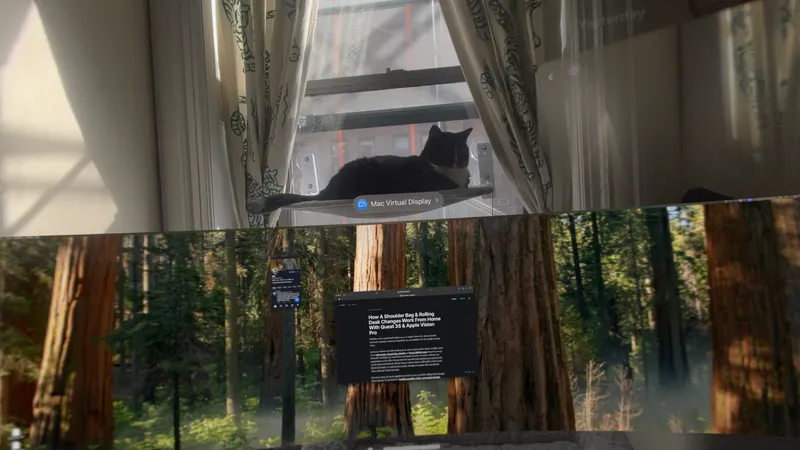For anyone who’s ever been motion sick, this advice should sound familiar: “Look at something that isn’t moving”. For some of us it works like a charm, and to this day the medical profession…isn’t really sure what’s going on. With the advent of consumer grade VR, the unfortunate prevalence of simulator sickness might require a large segment of us to keep a can of ginger ale and a wastebasket at arms reach. Such was the case for Dr. David Whittinghill and his research team at Purdue University, after enthusiastically taking the Oculus DK1 for a whirl and almost losing their lunch in the process.
According to mainstream research, simulator sickness and motion sickness are actually two distinct phenomena, albeit with several overlapping manifestations and triggers. Dr. Whittinghill presented 3 popular theories to explain sim-sickness:
1) Sensory Conflict Theory, which is when your eyes and inner ear are sending conflicting information to your brain.
2) Postural Instability Theory, which claims that uncontrolled instability in your posture can induce nausea and other symptoms.
3) Oculomotor systems theory, which speculates that the body’s attempt to adapt to the unnatural movement and stimulus of a simulated reality causes fatigue and the onset of sickness.
The Doctor was understandably crestfallen when he found he couldn’t spend more than 10 minutes inside the DK1 before the onset of severe discomfort. His team didn’t fare much better. One day, one of his researchers happened upon a demo that put the player inside the cockpit of an enormous battlemech. To his surprise, his sickness tolerance improved significantly. The rumor became that having a fixed visual reference point directly in the player’s field of view, (in this case, the cockpit frame and dashboard of the piloted mech), provided 3 key alleviating effects:
1) A focal point for the eyes to rest on as needed when motion outside the cockpit was disorienting
2) A more natural replication of a real physical context (sitting in a vehicle with a static foreground and dynamic background)
3) A simulation that allows for the brain to anticipate movement, and set expectations for the effects, by giving full locomotive control to the player.
Eureka! This example, along with many other pieces of anecdotal evidence, suggested that a method of incorporating fixed visual references into VR games could have a big impact on the frequency and severity of sim-sickness in VR. However, the solution couldn’t be intrusive or distracting – it needed to blend into the scenery as a subtle but universal reference point. In a stroke of ingenuity, Dr. Whittinghill came up with…Noses.
Using the popular Tuscany Villa and Roller Coaster demos as templates, Dr. Whittinghill and his team subtly incorporated the contours of a nose on each corresponding side of the display, exactly where it would appear in ones’ peripheral vision. In real life we’re hardly ever aware that the sides of our nose actually take up some real estate in the inner corners of our visual field – it’s always out of focus and our brains are used to ignoring it. They were curious as to whether that perception would both translate accurately into VR and if it could serve to reduce sim-sickness by serving as the subtle fixed reference point they were looking for.
A basic study was conducted, with an experiment group (nose) and control group (sans nose). Not only did the presence of the nose increase the sickness-free playtime for the experiment group, but bizarrely enough, not one participant realized the nose was there until the researchers pointed it out on a flat-panel monitor. Indeed, the VR nose was just as quasi-invisible as our real ones are, and yet seemed to have an actual effect on the onset and severity of sim-sickness.
So what have Dr. Whittinghill and his team proved? Unfortunately there are still more questions than answers. Perhaps there’s a mechanism at work related to proprioception that helps calibrate our sense of spacial orientation, giving us a buffer against other sensory conflicts. Perhaps it’s something else entirely. Larger studies need to be conducted to rule out a multitude of variables. Nevertheless, one promising and verifiable result showed that there was absolutely no variance in effect based on race, gender or age, suggesting that whatever is going on affects everyone in largely the same way.
We know we get sick when “seeing” and “feeling” are out of sync. Palmer Lucky has been quoted saying that “things that make you sick in real life will make you sick in VR”. But even avoiding those kinds of experiences is no guarantee of relief. Our bodies are finely attuned and accustomed to the normal physical forces that act on us every day. We generally aren’t conscious of these forces, but our sensory systems anticipate their effects and rely on their predictability in order for our brain to process and interpret those signals accurately. Otherwise we get eaten by a lion and evolution wins.
In virtual reality, merely the illusion of discordant sensory input can tie a stomach in knots. The exact physiological pathways and root causes of why we respond in such a nasty way to this kind of discoordination are still unclear. It’s also a mystery why there seems to be significant variance in individual susceptibility to sim-sickness. For as long as these issues persist, it presents a significant hurdle to mainstream proliferation of VR.
At the very least, Dr. Whittinghill’s research ought to prompt more experimentation in incorporating visual elements that help alleviate disorientation and nausea. You don’t need a VR nose to realize how much sim-sickness stinks.





























